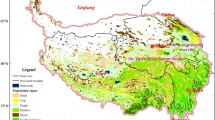Abstract
Plateau vegetation is considered to be highly sensitive to climate change, especially at higher altitudes. Although the Tibetan Plateau has experienced intensive warming over the past few decades, there is much contradictory evidence regarding its phenological variations and the impact of climatic change. In this study, we explored vegetation phenology through the inflexion point-based method with the weekly 0.05° EVI2 datasets from 1982 to 2010. We observed complex spatiotemporal variations in vegetation phenology on the higher Tibetan Plateau from three aspects. From a spatial aspect, the altitudinal gradients of phenological dates, as well as their directions, varied among different altitudes over the past three decades. Compared with delaying with elevation at altitudes below 5000 m, the phenological parameters at altitudes above 5000 m significantly advanced with increasing altitudes. At higher altitudes, much stronger altitudinal gradients (slope) of phenological dates were observed in the 2000s than in the 1980s and 1990s, i.e., 2.19, 3.47, and 3.68 days’ advance for start, maximum, and end dates, respectively, compared to less than 1 day’s change per 100 m increase in altitude. From a temporal dynamic aspect, when analyzed at different altitudinal bands, the dynamic trends in phenological dates were generally not significant except the advancing trends in the maximum dates at altitudes above 5000 m and the delaying trend in the end dates at altitudes of 4500–5000 m in the twenty-first century. Remarkable elevation dependency was also observed at the pixel level: increasing amplitudes of phenological dynamic trends were observed at higher altitudes when obtaining their minimum around 5000 m. These spatiotemporal variations of vegetation phenology were due to combined effects from both temperature and precipitation: more abundant rainfall and greater magnitudes of dynamic trends were observed in the average daily minimum temperature (slope = 0.08 °C/year) and annual precipitation (slope = 2.17 mm/year) at higher altitudes.










Similar content being viewed by others
References
Atzberger C, Eilers PH (2011) Evaluating the effectiveness of smoothing algorithms in the absence of ground reference measurements. Int J Remote Sens 32(13):3689–3709
Beurs KM, Henebry GM (2010) Spatio-temporal statistical methods for modelling land surface phenology. In: Keatley MR (ed) Hudson IL. Springer, Phenological research, pp. 177–208
Cao M, Woodward FI (1998) Dynamic responses of terrestrial ecosystem carbon cycling to global climate change. Nature 393(6682):249–252
Chapman DS (2013) Greater phenological sensitivity to temperature on higher Scottish mountains: new insights from remote sensing. Glob Chang Biol 19(11):3463–3471. doi:10.1111/gcb.12254
Che M, Chen B, Innes JL, Wang G, Dou X, Zhou T, Zhang H, Yan J, Xu G, Zhao H (2014) Spatial and temporal variations in the end date of the vegetation growing season throughout the Qinghai-Tibetan Plateau from 1982 to 2011. Agric For Meteorol 189(1):81–90
Chen X, An S, Inouye D, Schwartz M (2015) Temperature and snowfall trigger alpine vegetation green-up on the world’s roof. Glob Chang Biol 21(10):3635–3646
Dash J, Jeganathan C, Atkinson PM (2010) The use of MERIS Terrestrial Chlorophyll Index to study spatio-temporal variation in vegetation phenology over India. Remote Sens Environ 114(7):1388–1402
Ding M, Zhang Y, Sun X, Liu L, Wang Z, Bai W (2013) Spatiotemporal variation in alpine grassland phenology in the Qinghai-Tibetan Plateau from 1999 to 2009. Chin Sci Bull 58(3):396–405
Ding M, Li L, Zhang Y, Sun X, Liu L, Gao J, Wang Z, Li Y (2015) Start of vegetation growing season on the Tibetan Plateau inferred from multiple methods based on GIMMS and SPOT NDVI data. J Geogr Sci 25(2):131–148. doi:10.1007/s11442-015-1158-y
Ding M-j, Li L-h, Nie Y, Chen Q, Zhang Y-l (2016) Spatio-temporal variation of spring phenology in Tibetan Plateau and its linkage to climate change from 1982 to 2012. J Mt SCI-Engl 13(1):83–94. doi:10.1007/s11629-015-3600-0
Dong M, Jiang Y, Zheng C, Zhang D (2012) Trends in the thermal growing season throughout the Tibetan Plateau during 1960–2009. Agric For Meteorol 166:201–206
Eilers PHC (2003) A perfect smoother. Anal Chem 75(14):3631–3636
Fan D, Zhu W, Pan Y (2014) Identifying an optimal method for estimating greenup date of Kobresia pygmaea alpine meadow in Qinghai-Tibetan Plateau. J Remote Sens 18(5):1117–1127
Guo L, Dai J, Wang M, Xu J, Luedeling E (2015) Responses of spring phenology in temperate zone trees to climate warming: a case study of apricot flowering in China. Agric For Meteorol 201(0):1–7. doi:10.1016/j.agrformet.2014.10.016
Hamed KH, Ramachandra Rao A (1998) A modified Mann-Kendall trend test for autocorrelated data. J Hydrol 204(1):182–196
Harris RB (2010) Rangeland degradation on the Qinghai-Tibetan plateau: a review of the evidence of itsmagnitude and causes. J Arid Environ 74:1–12
Jeganathan C, Dash J, Atkinson PM (2011) Mapping the phenology of natural vegetation in India using a remote sensing-derived chlorophyll index. Int J Remote Sens 31(22):5777–5796. doi:10.1080/01431161.2010.512303
Jeganathan C, Dash J, Atkinson PM (2014) Remotely sensed trends in the phenology of northern high latitude terrestrial vegetation, controlling for land cover change and vegetation type. Remote Sens Environ 143:154–170
Liu X, Zhu X, Zhu W, Pan Y, Zhang C, Zhang D (2014) Changes in spring phenology in the three-rivers headwater region from 1999 to 2013. Remote Sens 6(9):9130–9144
Liu L, Zhang X, Donnelly A, Liu X (2016) Interannual variations in spring phenology and their response to climate change across the Tibetan Plateau from 1982 to 2013. Int J Biometeorol:1–13. doi:10.1007/s00484-016-1147-6
Luo X, Chen X, Wang L, Xu L, Tian Y (2014) Modeling and predicting spring land surface phenology of the deciduous broadleaf forest in northern China. Agric For Meteorol 198–199(0):33–41. doi:10.1016/j.agrformet.2014.07.011
Peng DL, Zhou B, Li CJ, Huang WJ, Wu YP, Yang XH (2014) Phenological characteristics of the main vegetation types on the Tibetan Plateau based on vegetation and water indices. IOP Conference Series: Earth and Environmental Science 17(1):012077
Peñuelas J, Filella I (2001) Responses to a warming world. Science 294(5543):793–795
Piao SL, Fang J, Zhou L, Ciais P, Zhu B (2006) Variations in satellite-derived phenology in China’s temperate vegetation. Glob Chang Biol 12(4):672–685. doi:10.1111/j.1365-2486.2006.01123.x
Piao SL, Cui M, Chen A, Wang X, Ciais P, Liu J, Tang Y (2011) Altitude and temperature dependence of change in the spring vegetation green-up date from 1982 to 2006 in the Qinghai-Xizang Plateau. Agric For Meteorol 151(12):1599–1608
Qader SH, Atkinson PM, Dash J (2015) Spatiotemporal variation in the terrestrial vegetation phenology of Iraq and its relation with elevation. Int J Appl Earth Obs 41:107–117. doi:10.1016/j.jag.2015.04.021
Qiu BW, Zhong M, Tang ZH, Chen CC (2013) Spatiotemporal variability of vegetation phenology with reference to altitude and climate in the subtropical mountain and hill region, China. Chin Sci Bull 58(23):2883–2892. doi:10.1007/s11434-013-5847-6
Qiu BW, Feng M, Tang ZH (2016) A simple smoother based on continuous wavelet transform: comparative evaluation based on the fidelity, smoothness and efficiency in phenological estimation. Int J Appl Earth Obs 47:91–101. doi:10.1016/j.jag.2015.11.009
Rathcke B, Lacey EP (1985) Phenological patterns of terrestrial plants. Annu Rev Ecol Syst:179–214
Reed BC, Brown JF, VanderZee D, Loveland TR, Merchant JW, Ohlen DO (1994) Measuring phenological variability from satellite imagery. J Veg Sci 5(5):703–714
Shen M, Tang Y, Chen J, Zhu X, Zheng Y (2011) Influences of temperature and precipitation before the growing season on spring phenology in grasslands of the central and eastern Qinghai-Tibetan Plateau. Agric For Meteorol 151(12):1711–1722. doi:10.1016/j.agrformet.2011.07.003
Shen M, Zhang G, Cong N, Wang S, Kong W, Piao S (2014) Increasing altitudinal gradient of spring vegetation phenology during the last decade on the Qinghai-Tibetan Plateau. Agric For Meteorol 189:71–80
Shen M, Piao S, Cong N, Zhang G, Jassens IA (2015) Precipitation impacts on vegetation spring phenology on the Tibetan Plateau. Glob Chang Biol 21(10):3647–3656
Sobrino JA, Julien Y, Morales L (2011) Changes in vegetation spring dates in the second half of the twentieth century. Int J Remote Sens 32(18):5247–5265. doi:10.1080/01431161.2010.496470
Verger A, Filella I, Baret F, Peñuelas J (2016) Vegetation baseline phenology from kilometric global LAI satellite products. Remote Sens Environ 178:1–14. doi:10.1016/j.rse.2016.02.057
Walker JJ, de Beurs KM, Wynne RH (2014) Dryland vegetation phenology across an elevation gradient in Arizona, USA, investigated with fused MODIS and Landsat data. Remote Sens Environ 144:85–97
Wang H, Ma M, Wang X, Yuan W, Song Y, Tan J, Huang G (2013) Seasonal variation of vegetation productivity over an alpine meadow in the Qinghai–Tibet Plateau in China: modeling the interactions of vegetation productivity, phenology, and the soil freeze–thaw process. Ecol Res 28(2):271–282
Wang C, Guo H, Zhang L, Liu S, Qiu Y, Sun Z (2015a) Assessing phenological change and climatic control of alpine grasslands in the Tibetan Plateau with MODIS time series. Int J Biometeorol 59(1):11–23. doi:10.1007/s00484-014-0817-5
Wang H, Liu D, Lin H, Montenegro A, Zhu X (2015b) NDVI and vegetation phenology dynamics under the influence of sunshine duration on the Tibetan plateau. Int J Climatol 35(5):687–698. doi:10.1002/joc.4013
Wang XH, Piao SL, Xu XT, Ciais P, MacBean N, Myneni RB, Li L (2015c) Has the advancing onset of spring vegetation green-up slowed down or changed abruptly over the last three decades? Glob Ecol Biogeogr 24(6):621–631. doi:10.1111/geb.12289
White MA, Beurs D, Kirsten M, Didan K, Inouye DW, Richardson AD, Jensen OP, O'Keefe J, Zhang G, Nemani RR (2009) Intercomparison, interpretation, and assessment of spring phenology in North America estimated from remote sensing for 1982-2006. Glob Chang Biol 15(10):2335–2359
Wu C, Gonsamo A, Gough CM, Chen JM, Xu S (2014) Modeling growing season phenology in north American forests using seasonal mean vegetation indices from MODIS. Remote Sens Environ 147:79–88
Yi S, Zhou Z (2011) Increasing contamination might have delayed spring phenology on the Tibetan plateau. Proc Natl Acad Sci 108(19):E94. doi:10.1073/pnas.1100394108
Yu H, Luedeling E, Xu J (2010) Winter and spring warming result in delayed spring phenology on the Tibetan Plateau. Proc Natl Acad Sci 107(51):22151–22156. doi:10.1073/pnas.1012490107
Yu H, Xu J, Okuto E, Luedeling E (2012) Seasonal response of grasslands to climate change on the Tibetan Plateau. PLoS One 7(11):e49230. doi:10.1371/journal.pone.0049230
Zhang X, Friedl MA, Schaaf CB, Strahler AH (2004) Climate controls on vegetation phenological patterns in northern mid- and high latitudes inferred from MODIS data. Glob Chang Biol 10(7):1133–1145
Zhang G, Zhang Y, Dong J, Xiao X (2013) Green-up dates in the Tibetan Plateau have continuously advanced from 1982 to 2011. Proc Natl Acad Sci 110(11):4309–4314
Zhang X, Tan B, Yu Y (2014) Interannual variations and trends in global land surface phenology derived from enhanced vegetation index during 1982–2010. Int J Biometeorol 58(4):547–564
Acknowledgments
This work was supported by the National Natural Science Foundation of China (grant no. 41471362).
Author information
Authors and Affiliations
Corresponding author
Rights and permissions
About this article
Cite this article
Qiu, B., Zhong, J., Tang, Z. et al. Greater phenological sensitivity on the higher Tibetan Plateau: new insights from weekly 5 km EVI2 datasets. Int J Biometeorol 61, 807–820 (2017). https://doi.org/10.1007/s00484-016-1259-z
Received:
Revised:
Accepted:
Published:
Issue Date:
DOI: https://doi.org/10.1007/s00484-016-1259-z




